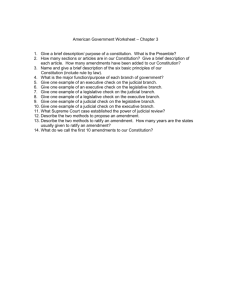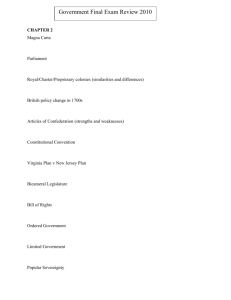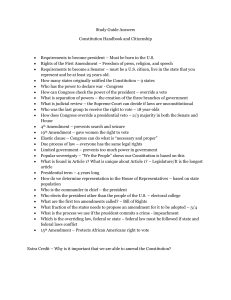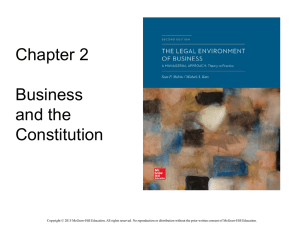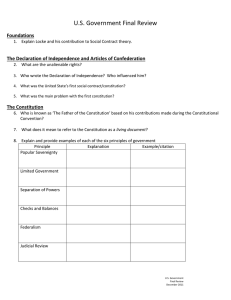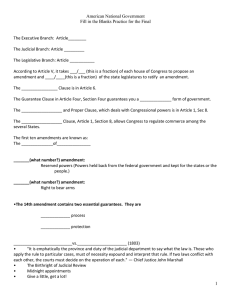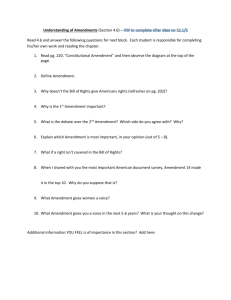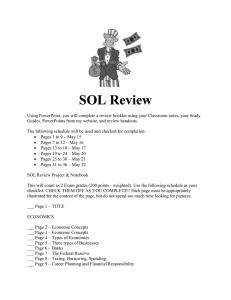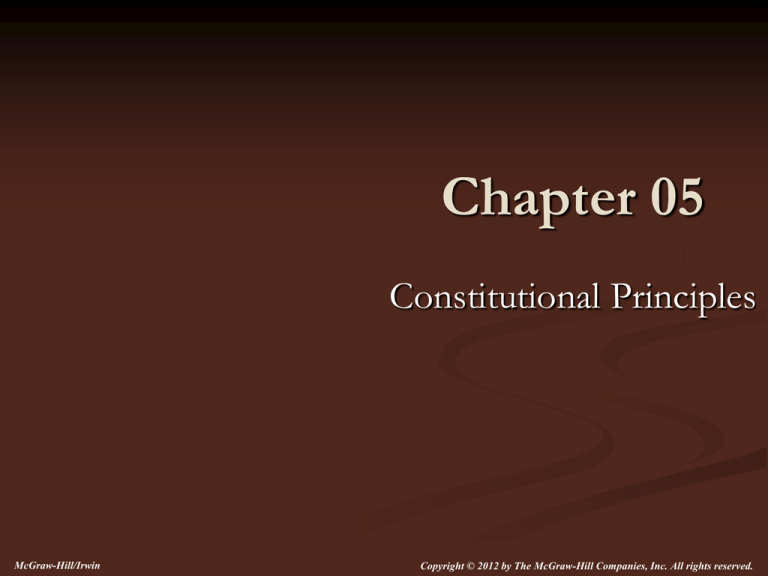
Chapter 05
Constitutional Principles
McGraw-Hill/Irwin
Copyright © 2012 by The McGraw-Hill Companies, Inc. All rights reserved.
The United States Constitution
Establishes a “federalist” system of government
(with authority divided between the federal and
state governments)
Allocates power among the three federal
branches of government (legislative, executive,
and judicial)
Establishes a system of “checks and balances”
5-2
Figure 5-1: The System of Checks and Balances
Legislative Branch (U.S. Congress)
On Executive Branch:
On Judicial Branch:
Can refuse to approve
president’s budget
Can overrule presidential vetoes
Can refuse to approve
presidential appointees
Can refuse to ratify treaties
Can impeach and remove
president
Can pass amendments to
overrule judicial rulings
Can impeach judges
Establishes lower courts and
sets number of judges
5-3
Figure 5-1: The System of Checks and Balances
Executive Branch (U.S. President)
On Legislative Branch:
On Judicial Branch:
Can veto laws passed by
legislative branch
Can call special sessions of
Congress
Appoints federal judges
Can pardon federal offenders
5-4
Figure 5-1: The System of Checks and Balances
Judicial Branch (U.S. Federal Court System)
On Legislative Branch:
On Executive Branch:
Can declare laws passed by
Congress unconstitutional
Can declare acts of the
Executive Branch
unconstitutional
5-5
The Supremacy Clause (Article VI of the
United States Constitution)
Provides that federal law is the “supreme law” of the
United States
Any state or local law that directly conflicts with federal
law is void
5-6
The Commerce Clause (Article I, Section 8 of
the United States Constitution)
The primary source of authority for federal regulation
of business
States that the U.S. Congress has the power to “regulate
Commerce with foreign Nations, and among the
several States…”
Simultaneously empowers the federal government and
restricts the power of state governments
5-7
Taxing and Spending Powers of the Federal
Government (Article I, Section 8 of the United
States Constitution)
Provides the power to “lay and collect Taxes, Duties,
Imports and Excises.”
Taxes imposed by Congress must be uniform across
the states
The federal government can use tax revenues to
provide essential services, encourage development of
certain industries, discourage development of other
industries
Regulatory impact of tax does not affect its
constitutionality
5-8
Other Constitutional Restrictions on
Government
Privileges and Immunities Clause
Full Faith and Credit Clause
Contract Clause
5-9
Exhibit 5-1: Summary of the Bill of Rights:
The First Amendment
Protects freedom of religion, press, speech, and
peaceable assembly
Ensures that citizens have the right to ask the
government to redress grievances
5-10
Exhibit 5-1: Summary of the Bill of Rights:
The Second Amendment
Finds that in light of the need for a wellregulated militia for security, government cannot
infringe on citizens’ right to bear arms
5-11
Exhibit 5-1: Summary of the Bill of Rights:
The Third Amendment
Provides that government cannot house soldiers
in private residences during peacetime, or during
war, except for provisions in the law
5-12
Exhibit 5-1: Summary of the Bill of Rights:
The Fourth Amendment
Protects citizens from unreasonable search and
seizure
Ensures that government issues warrants only
with “probable cause”
5-13
Exhibit 5-1: Summary of the Bill of Rights:
The Fifth Amendment
Ensures that government does not put citizens on trial
except upon indictment by a grand jury
Gives citizens the right not to testify against themselves
(privilege against self-incrimination)
Prevents government from trying citizens twice for the
same crime (double jeopardy)
Creates the right to due process
Provides that government cannot take private property
for public use without just compensation
5-14
Exhibit 5-1: Summary of the Bill of Rights:
The Sixth Amendment
Provides the right to a speedy public trial with an
impartial jury
Provides the right to know what criminal accusations a
citizen faces
Provides the right to have witnesses both against and
for the accused
Provides the right to an attorney
5-15
Exhibit 5-1: Summary of the Bill of Rights:
The Seventh Amendment
States that in common law suits where the monetary
value exceeds $20, citizens have the right to a jury trial
5-16
Exhibit 5-1: Summary of the Bill of Rights:
The Eighth Amendment
Provides that government will not set excessive bail
Prohibits government imposition of excessive fines
Prohibits cruel and unusual punishment
5-17
Exhibit 5-1: Summary of the Bill of Rights:
The Ninth Amendment
Provides that although the Bill of Rights names certain
rights, such naming does not remove other rights
retained by citizens
5-18
Exhibit 5-1: Summary of the Bill of Rights:
The Tenth Amendment
Provides that powers that the U.S. Constitution does
not give to the federal government are reserved to the
states
5-19
The Fourteenth Amendment of the United
States Constitution (the “Equal Protection”
Clause)
Prevents states from denying “the equal protection of
the laws” to any citizen
Combats discrimination, since it applies whenever
government treats certain individuals differently than
other “similarly-situated” individuals
5-20
Judicial Tests to Determine Violations of the
Fourteenth Amendment
“Strict Scrutiny” Test: Applies to “suspect classifications” based
on race, national origin, and/or citizenship that would prevent
individuals from exercising a fundamental right (such
classification allowed only if necessary to promote a “compelling
state interest”)
“Intermediate Scrutiny” Test: Applies to classifications based on
gender or on the legitimacy of children (such classification
allowed only if it is substantially related to an “important
government objective”)
“Rational Basis” Test: Applies to all other matters (such
classification allowed only if it advances a “legitimate
government interest”)
5-21

